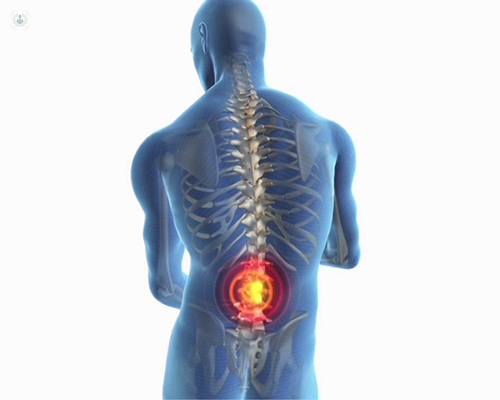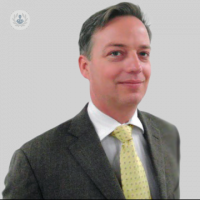Pain in the back: treating spinal stenosis (spinal pain)
Written by:Spinal canal stenosis is a condition which affects 11% of The UK’s population, causing patients to suffer from severe pain in the lower back and legs. We speak to highly experienced spinal surgeon Mr Andrew James, who explains the prominent causes of the condition and its most effective treatment method.

What causes spinal stenosis?
The most frequent cause of lumbar canal stenosis is lumbar vertebral osteoarthritis. Although it is a benign disease, it cannot be cured and evolves slowly, making walking increasingly difficult.
What are the symptoms of spinal stenosis?
The symptom that characterises spinal stenosis is back pain and, in particular, pain in the legs while walking. This pain results in a progressive decrease in the patient’s quality of life. Relief is achieved by stopping and sitting, however, pain reappears when the patient begins to walk again (claudication).
Although leg pain usually appears progressively, sometimes it can be acute and sudden. In some patients, the pain is accompanied by numbness of the legs, and in some cases, patients feel a loss of strength.
Depending on the time of onset and the intensity of the symptoms, the treatment for spinal stenosis can range from physical exercise and epidural infiltrations, to surgery, in order to eliminate the compression of the nerves caused by the stenosis. However, due to the aggressive nature of the surgery and the anaesthetic risk, in some cases, this treatment is not possible.
What does spinal stenosis treatment involve?
Injections of cortisone derivatives into the spine can be used as an alternative to spinal surgery, as a method of pain reduction. Although some patients may see these injections as a favourable alternative to surgery, they must be aware that they can pose the risk of some undesirable side effects, which can be particularly common in elderly, diabetic or hypertensive patients.
Ozone therapy
An alternative treatment to epidural corticosteroid injections is the administration of ozone. Ozone is a gas with anti-inflammatory and antioxidant properties that has been proven effective for many years in osteoarthritis of joints (knee, hip, shoulder, hands), in paravertebral muscular pains and lower back pain, and sciatica by hernias or disc protrusions.
Ozone injections for the treatment of lumbar canal stenosis achieve results similar to those obtained with the use of cortisone, but without the side effects.
The treatment consists of two outpatient injections 7-15 days apart. Occasionally, a third is needed to increase relief and prolong the duration of the effect.
To administer the treatment, an epidural puncture is performed with the usual rules of asepsis. It can be performed as an outpatient treatment without hospitalisation. During the treatmemt, the patient remains lying on the table for 20-30 minutes after the injection, then can go home.
If the treatment is effective, it should be repeated after 4-6 months.
Ozone injections may not always be effective against spinal stenosis, as with all osteoarthritis treatments, but the lack of better alternatives places it in among the best and preferable non-surgical treatments for the management of disabling pain in patients with canal stenosis.
If you are suffering from severe back and leg pain and would like to book a consultation with Mr James, simply visit his Top Doctors profile today.



